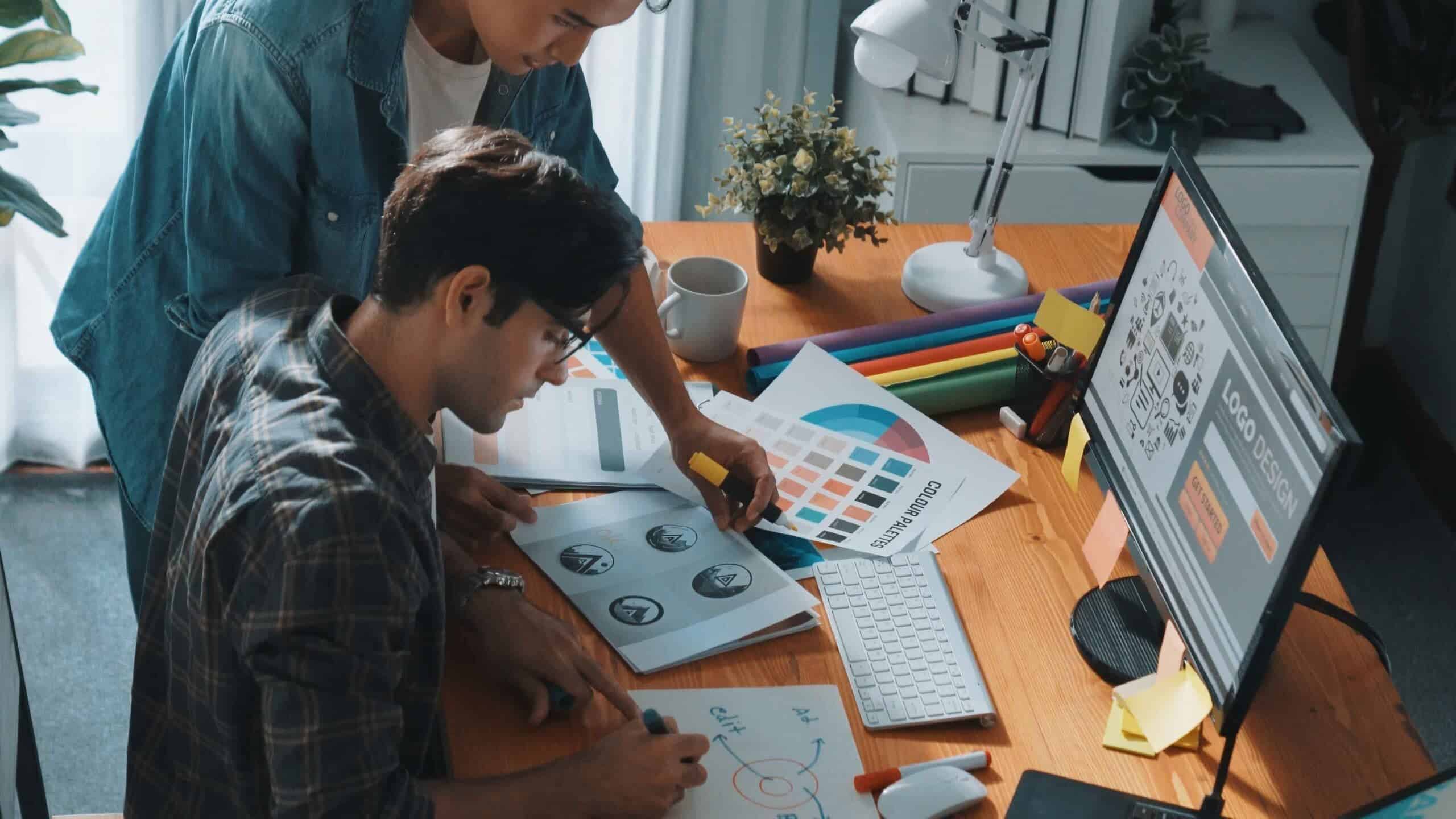In today’s world of marketing, graphic design plays a growing role in establishing and building brand identities. If you’ve been considering a career in graphic design, it’s important to understand the importance of this work as it relates to enhancing brand visibility, supporting marketing campaigns, and more.
With an understanding of what brand identity entails plus graphic design’s specific role in visual identity design, you can be better prepared to make an impression in this competitive field.
Fundamentals of Brand Identity Design
So, what exactly is brand identity, and why does it matter in marketing? Let’s dive in.
Defining Brand Identity
Specifically, brand identity refers to the traits and characteristics that impact how the brand of an organization is perceived by its audience. This includes the brand’s personality, as well as how it presents itself, and its overall reputation.
Building a strong and positive brand identity is essential for an organization of any size because it offers an opportunity for the organization to set itself apart from its competition. Likewise, having a strong brand identity can directly influence a brand’s reputation, helping organizations build closer relationships with their audiences.
Sometimes, the terms “brand identity” and “brand image” are used interchangeably, but it is paramount to understand that these are actually two different concepts. Specifically, brand image refers more to how the audience perceives a company based on a wide range of factors, whereas brand identity refers to efforts that come directly from the brand to intentionally curate a particular image .
Elements of Brand Identity
Several elements make up a brand identity, including:
- Brand personality – This element aims to humanize the brand by associating certain traits or characteristics to the business itself, such as a sense of humor
- Brand story – Brand story refers to the history and narrative of a brand and its origins of why this organization exists and what it is striving towards.
- Communication – This refers to the many ways that a brand chooses to communicate with its audiences, including social media, blogs, press releases, or general marketing efforts.
- Product/service offering – The specific products and/or services offered by a brand can also affect its image, especially when it comes to the perception of value and quality.
- Brand name – The actual name of the business can also have a major impact on brand image, as a memorable brand name can improve recall and help establish a strong reputation.
- Visual identity – This critical aspect of brand identity is centered around the graphic design elements that differentiate the brand itself, ranging from the brand logo and brand imagery to the color palette and typefaces used.
From a graphic design perspective specifically, marketing collateral design includes everything from print materials to blog posts, landing pages, eBooks, and infographics.
The Process of Designing a Brand Identity
As businesses look to establish a brand identity, decision-makers often begin by working with experienced marketing teams, advertising professionals and graphic designers to make a unique visual brand. In some cases, other experts may also be involved, including strategists and leaders.
Initial Concept and Research
During the initial concept and research phase, creating a strong brand identity begins with establishing the company’s intended audience and their needs/preferences. From there, it is possible to build solid marketing campaigns that cater to those specific demographics.
Graphic design and corporate identity design are critical to this phase because this is when graphic designers begin brainstorming ideas for logos, color schemes, imagery, and other critical elements that can affect brand image. With this in mind, it is so important for graphic designers to be heavily involved with the initial concept and research process while also understanding the brand’s unique mission, values, and personality.
Design Development and Iteration
As the process of forming a brand identity continues, graphic designers play a vital role in transforming ideas into reality. It is common for graphic designers to present numerous possibilities for logos, color palettes, typography, and other graphic components for the brand’s website, print materials, and other digital marketing campaigns.
Once a specific brand communication design is agreed upon, graphic designers are responsible for implementing these designs on all brand media and ensuring consistency with everything the company publishes in the future.
Graphic Design’s Impact on Marketing Strategy
When graphic and interactive media design aligns with a brand’s values and mission, it can have a huge impact on brand identity and long-term success. From boosting brand visibility and recognition to improving the return on investment (ROI) of marketing campaigns, the right graphic design choices can make all the difference.
Enhancing Brand Visibility
First, graphic design can be used to enhance the overall visibility of a brand. When a brand has a logo, color palette, typeface, and other visual characteristics that are readily identifiable, this can help build brand image and visibility throughout target audiences.
Of course, it’s crucial to note that great graphic design goes beyond logos and fonts. It also covers the way a website is laid out and composed of illustrations and images that will improve brand recognition.
Supporting Marketing Campaigns
Graphic design can also be used to support marketing campaigns by increasing effectiveness. This is especially true for social media, email, and even print marketing campaigns because images and graphics that align with the brand’s overall image can build recognition and loyalty.
In many ways, graphic design in marketing can have a direct impact on conversions and sales. For example, a survey found that about 63 percent of customers make buying decisions based on aesthetics and design alone.
Digital and Multimedia Design Considerations
When working with a business to build a brand identity, there are many considerations that graphic designers must keep in mind. This is especially true when it comes to adapting existing brand identities to digital media and incorporating brand characteristics into video and interactive media.
Adapting Brand Identity for Digital
In some cases, graphic designers may work with businesses that have already established a brand identity or a reputation with the local community but lack much of an online presence. When this occurs, graphic designers face the challenge of translating that brand identity into digital components, such as the company’s website and digital marketing materials.
This is where it becomes crucial for designers to comprehend a brand, their values, and the relationships they have with their customers. Otherwise, graphic designers will not be able to effectively adapt brand identity components to digital media. From there, designers can ensure consistency between print and digital marketing materials.
Video and Interactive Media
Incorporating elements of brand identity into other types of media, such as video and interactive media, can also present some challenges. For instance, a graphic designer may be asked to incorporate elements of a brand’s identity into a new app that is being developed for customers. Graphic designers would then have the responsibility of making sure that the app uses the correct logo, color scheme, typography, and other elements that will effectively project the brand’s image to users. These same concepts also apply when working with other types of media, including videos, interactive advertisements, and more.
Case Studies: Successful Brand Identity Transformations
To understand the impact that graphic design has on brand identity, it helps to look at successful brand identity transformations from real companies.
Before and After
Perhaps the most iconic example of graphic design transforming a brand is Airbnb. After a fairly successful launch, the online vacation company decided to rebrand its website and app with a new logo that it hoped would better reflect its brand identity.
The logo, which has now been in use for more than a decade, consists of four elements meant to represent people, places, and a love of travel. Collectively, these elements in the logo make up an “A” for Airbnb.
This new logo did an incredible job of communicating the brand’s values and vision not just to the American marketplace, but also on a global scale. In fact, it even won a number of awards and, according to the Airbnb website, “is still globally recognized as category-defining.”
Lessons Learned
At the end of the day, the most important lesson that graphic designers can learn when helping a company establish brand identity is knowing your audience. When you take the time to conduct audience research, you can craft designs that capture their attention and inspire them.
Learn More in a Graphic Design Program
From establishing brand aesthetics to ensuring brand consistency in marketing campaigns, graphic design plays a critical role in how businesses are perceived. With a solid background in marketing graphic design, you can help businesses of all scopes and sizes establish and build strong identities within their respective industries.
Interested in learning more about marketing campaign design? It may be time to pursue your graphic design degree. Specifically, a Bachelor of Fine Arts in Graphic Design from Rocky Mountain College of Art + Design can prepare you to communicate, solve problems, and build brand identities using your artistic talents. RMCAD is proud to offer a graphic design degree both online and on-campus to meet your needs, with courses covering user experience (UX), industry design software, typography, storytelling, and much more. Reach out to learn more about this program today, or get started with your online application.

